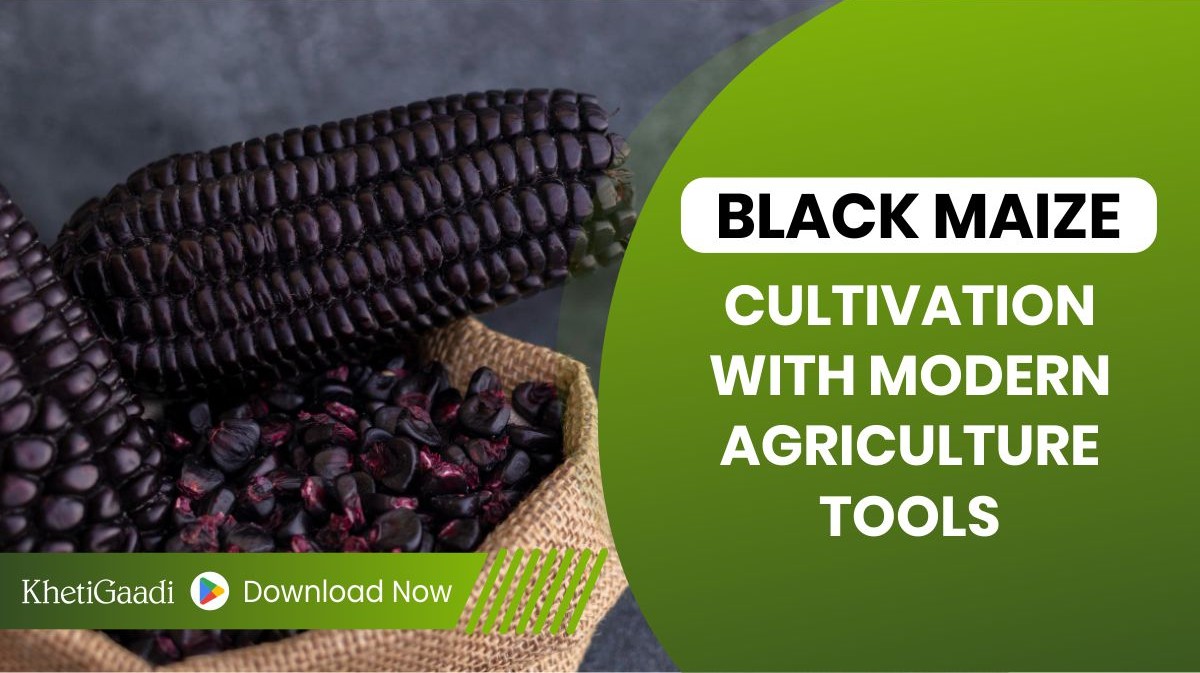Black Maize Farming Guide for Indian Farmers
In today’s agriculture, the agricultural landscape is changing. As a result, farmers are looking for innovative ways to diversify crops and increase profits. One new area of interest on the horizon may be higher-valued crops like black corn, which is also known as black maize. With deep purple-black kernels reminiscent of a junior year art project stint at college, this crop not only strikes a dramatic pose but is also nutritionally full of good stuff. It carries a high price in premium markets too. Black corn farming is emerging as a smart way forward for forward-thinking farmers seeking to tap the health-conscious consumer and speciality food markets.
This article introduces the cultivation process of black corn, discusses its benefits for farmers and its economic potential, and provides useful agricultural tools. I will also cover the most important things you need to know about raising this high-value crop from seed all the way through to harvest: Prime areas where good land is available are key.
What is Black Corn?
Black corn is a distinctive type of maize, recognizable by its dark pigmentation, a feature that comes from the high levels of anthocyanins it contains, powerful antioxidants also found in black rice and blueberries. Originating in South America, people not only appreciate the visual appeal of black corn but also its nutritional benefits.
Black corn contains :
- More antioxidants than conventional yellow maize
- More protein and Dietary Fiber
- Lower sugar content
- Anti-inflammatory and anti-cancer properties
Currently, with Black Corn’s health value, people in health food stores, organic markets, and restaurants are clamouring for it.
Economic Potential: Why Choose Black Corn Cultivation?
Traditional corn has for a long time been the staple diet in many areas. But black corn cultivation offers a way in for farmers to break into premium markets. Black corn carries a price 3-4 times that of yellow corn, depending on the quality and market demand.
Outstanding economic advantages include :
High market value— black maize is regarded as a foreign food, and it is also healthy to eat, making black maize a thing to seek after.
- Low input costs: Back maize is grown under similar techniques and tools as yellow maize.
- Exports: global demand is increasing year by year, especially from health-conscious countries.
- Value-added products: Black corn can be employed in the production of flour, chips, popcorn, and syrup—each of which adds value to the raw product.
Ideal Climate and Soil Conditions
Like ordinary corn, black corn promotes warm, sunny weather. Best of all is that it is adaptable to both tropical and subtropical areas. It can be grown in temperate regions as well, with proper care.
Soil Requirements
- Well-drained, rich in humus loam soil
- PH value 6.0 & 7.5
- Soil temperature over 10°C for most seeds to germinate
Easy soil aeration, together with better root formation, can be achieved through the use of modern agricultural implements such as rotavators, plows, and seed drills.
Seed Selection and Sowing
The success of black corn cultivation starts with the right seed of maize. Seeds must be free of disease, their germination must be high and approved, and they must be supplied by reputable organizations. High-yielding open-pollinating varieties and hybrids are both available, depending on the desired yield and the market.
Seed Rate and Spacing :
- Seeds Recommended Rate: 15-20 kg/acre
- Row with row spacing: 60-75 cm
- Plant-to-plant spacing: 20-25 cm
Depending on the size of the field and the availability of tools for farming, seeds are generally planted by seed drill or manually.
Crop Management Practices
Knowing how to manage your maize plant growth cycle can be your trick to your efficiency.
1. Irrigation:
- Requires 4–5 irrigations depending upon climate.
- From germinating, knee-high, and flowering to even grain-filling stages.
2. Fertilization:
- Add well-rotted farmyard manure to the soil before sowing.
- Use NPK fertilizers as per soil tests. Commonly used is 120:60:40 kg/ha of N:P:K.
- Micronutrient foliar sprays (such as zinc and boron) increase grain and yield quality.
3. Weed Management:
- Weeding at the right time is crucial for the first 30–40 days.
- Pre-emergent: use mechanical weeders or chemical herbicides like Atrazine.
Pest and Disease Control:
Common maize pests are as follows:
- Stem borers
- Fall armyworm
- Aphids
Creating a barrier, planting pest-resistant hybrids, and deploying IPM (Integrated Pest Management) are all part of the prevention effort.
Harvesting and post-harvest Handling
Maturation takes 90–120 days from sprouting, depending on variety and climatic conditions.
Signs of maturity:
- You know this quote about kernels from the book-turned-movie Black Lustre.
- The husk dries and turns brown.
- Stalks begin to lean.
We can harvest these fruits manually or using mechanical harvesters. Preservation of quality and prevention of spoilage are key during post-harvest handling of grains.
Key steps:
- 5–7 Days: Sun-dry maize grain
- Threshers for quicker separation
- Keep it in clean, dry, and well-ventilated storage areas below 12% moisture content.
Therefore, preventing insects and ensuring long storability.
Marketing and Profitability
The study of agricultural management, marketing systems, and processing techniques for black corn commercialization will help farmers achieve high benefits through direct sales and value-added sales.
Sales Options:
- Local organic markets
- Health food stores
- Food exporters and processors
- Collective marketing through online platforms and cooperatives
Value Addition Ideas:
- Dark corn flour for gluten-free baking
- The Principles of Popcorn for Professional Popping
- Corn syrup for natural sweeteners
- Fermented corn-based beverages and products
Farmers can expand their profit margins drastically by reinvesting in basic processing units.
The Modern Agriculture Tools:
It also decreases labor costs and increases productivity by utilizing modern agriculture tools effectively.
Key tools include:
- Rotavator: For making a fine seedbed
- Seed drill: For sowing seeds at regular intervals
- Boom Sprayer: Used to apply fertilizers and pesticides
- Mechanical harvester: for large-scale harvesting
- Thresher: For separating grain and cleaning
Timely operations, a key factor for black corn, are made certain through farm mechanization, which contributes to increased yield.
Government Support and Schemes
Yet there are several subsidiaries and schemes introduced that are promoted more with maize cultivation than by different central land state governments in India.
Including:
- Maize seed and farm implement subsidies
- Added costs of it, training, and awareness seminars
- Maize Minimum Support Price (MSP) schemes
- Encourage crop insurance and, through the Kisan Credit Card (KCC), a disciplined loan scheme.
Farmers may call their local agriculture departments to benefit from these items.
Challenges in Farming Black Corn
Black Corn: The problems and what might be done about them
- Black corn has its difficulties, even though it has made a good start.
- Lack of certified seeds in a few areas
- Pest outbreaks such as fall armyworm
- Issues in market linkage for remote ones
Yet all these difficulties can be dealt with by real experts, training, and cooperative models of practice.
Future Scope of Black Corn in Indian Agriculture
As consumers progressively turn to healthy and organic foods, black corn maize is expected to become a major maize grain type for both home use and export in the future. Clever packaging, a good commercial name, and marketing can turn black corn into a sector-wide leader in small farmer income.
Since corn is a resilient crop to production risk and needs fewer inputs than wheat and rice do, cultivating black corn is also a practice in sustainable agriculture.
Conclusion
Black corn enjoys a special position as an opportunity to make money for those farmers who want to do something different in this era. Falling back on black corn as a dead-end alternative to ordinary maize crops is not a likely prospect: not only does it have a higher nutritional value than ordinary maize, but it is also one of the most suitable crops of all for cultivation.
By using modern farming tools, efficient field management, and exploration of markets that are sold directly to consumers, farmers can open up new sources of income for themselves and their homeland. It also fits in very well with the development events and needs of food crops with good health offerings.
Black becomes gold. Again, in the agricultural world, growing black maize might mark the onset of profitable, modern farming.
Stay connected to the KhetiGaadi WhatsApp channel and get the latest updates on farming innovations and government schemes. Visit KhetiGaadi for more information and guidance.
Contact Khetigaadi for guidance and updates on agriculture schemes for farmers:
Phone: 07875114466
Email: connect@khetigaadi.com




